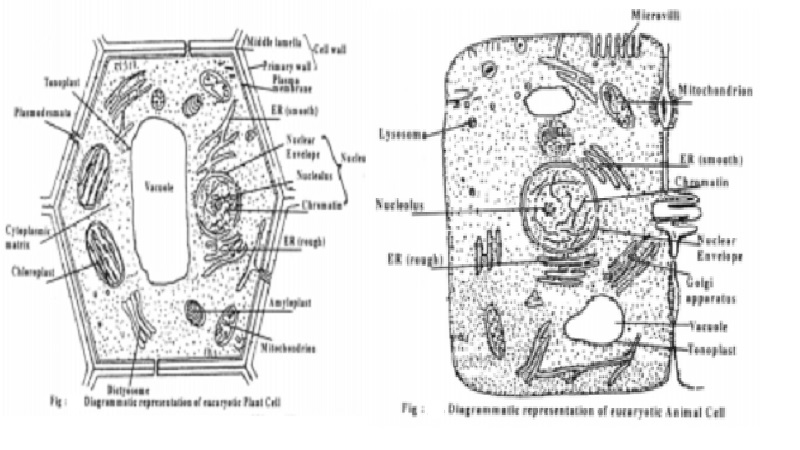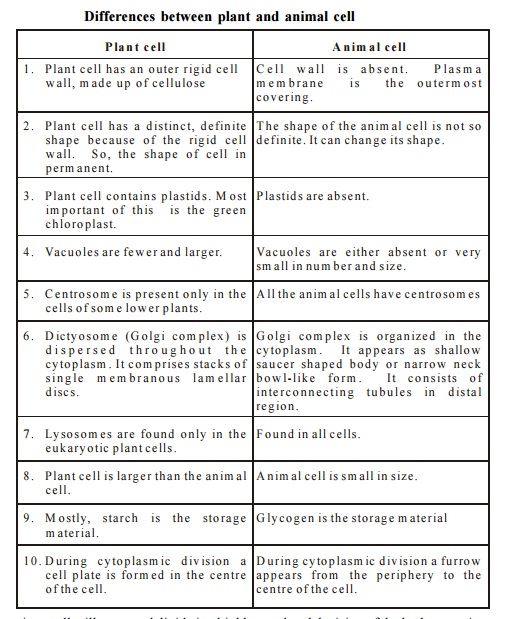Chapter: 11th 12th standard bio Biotany Plant Tree higher secondary school
Dynamic nature of cell , Difference Between Plant Cell And Animal cell

CELL BIOLOGY
A cell is a structural and functional unit of all living organisms. It is microscopic and capable of independent existence. All living things are made up of cells. The outward differences among the various biological forms may bewilder us. But underlying these differences is a powerful uniformity. That is all biological systems are composed of same types of molecules and they all employ similar principles of organization at the cellular level. We shall see for example, that all living organisms employ the same genetic code and a similar machinery for protein synthesis.
Organisms contain organs, organs composed of tissues, tissues are made up of cells; and cells are formed of organelles and organelles are made up of molecules. However, in all living organisms, the cell is the functional unit.All of biology revolves around the activity of the cell. Loewy and Siekevitz defined cell as a unit of an organism delimited by a plasma membrane in animal cells and cell wall and plasma membrane in plant cells. Thus cell forms the basic unit of life.
Dynamic nature of cell
A cell in an adult organism can be viewed as a steady - state system. The DNA is constantly read out into a particular set of mRNA (transcription) which specify a particular set of proteins (translation). As these proteins function they are being degraded and replaced by new ones and the system is so balanced that the cell neither grows, shrinks, nor changes its function. Considering this static view of the cell, however, one should not miss the all-important dynamic aspect of cellular life.
The dynamics of a cell can be best understood by examining the course of a cell's life. A new cell is formed when one cell divides or when two cells, (a sperm and an egg) fuse. Both these events start a cell-replication programme. This usually involves a period of cell growth, during which proteins are made and DNA replicated, followed by cell division when a cell divides into two daughter cells. Whether a given cell will grow and divide is a highly regulated decision of the body, ensuring that adult organism replaces worn out cells or makes new cells in response to a new need. The best example for the latter is the growth of muscle in response to exercise or damage. However, in one major and devastating disease namely cancer, the cells multiply even though there is no need in the body. the understand how
cells become cancerous, biologists have intensely studied the mechanism that controls the growth and division of cells.
Difference Between Plant Cell And Animal cell

Cell Cycle
The cell cycle follows a regular timing mechanism. Most eukaryotic cells live according to an internal clock, that is they proceed through a sequence of phases, called cell cycle. In the cell cycle DNA is Duplicated during synthesis (S) Phase and the copies are distributed to daughter cells during mitotic (M) phase.
Most growing plant and animal cells take 10-20 hours to double in number and some duplicate at a much slower rate.
The most complicated example of cellular dynamics occurs during differentiation i.e when a cell changes to carry out a specialized function. This process often involves changes in the morphology of a cell based on the function it is to perform. This highlights the biological principle that 'form follows function'
Unchecked cell growth and multiplication produce a mass of cells, a tumor. Programmed Cell Death (PCD) plays a very important role by balancing cell growth and multiplication. In addition, cell death also eliminates unecessary cells.
Related Topics